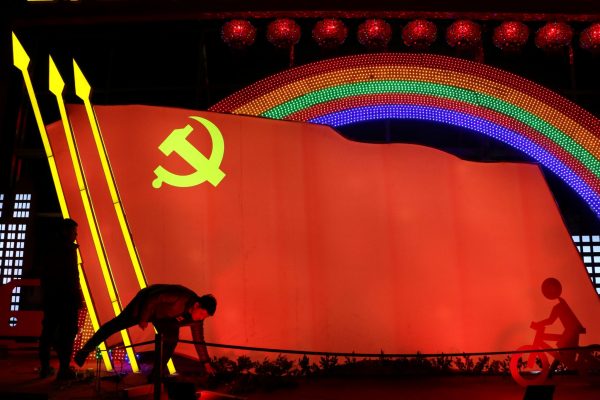Even though China and the United States are today nowhere near as ideologically divided as the United States and the USSR, a powerful narrative has emerged that the American-led model of free markets and liberal democracy is being challenged by a new Chinese model of development. The idea of a China model has gained traction on the back of decades of strong economic growth, and in the wake of Beijing’s success in steering the country through the Great Recession of 2008–09. Interest in a China model of development has also been boosted by the crises and instability confronting Western democracies, as well as the apparent failure of liberal democracy to deliver economic benefits and stability to many newly democratic countries in Asia and other parts of the world.
China’s success and its growing clout has prompted Western strategists to worry that Beijing will use its economic strength and influence to promote the Chinese model of development as an alternative to liberal democracy. Those anxieties are amplified by Chinese President Xi Jinping’s muscular approach to foreign affairs and grand ambitions to extend trade and investment across Eurasia under the auspices of the Belt and Road Initiative.
But what exactly is the China model and does it pose a threat to the Western model of liberal democracy and free markets? Within China, advocates for a China model point to a strong developmental state, gradual institutional reform, selective and cautious borrowing of foreign ideas, and a trial-and-error approach to policy making and reform. Western observers tend to highlight the heavy hand of the state in the economy (state capitalism) alongside the suppression of dissent and rejection of political liberalisation.
Although the Chinese Communist Party’s (CCP) successes are the envy of many political elites in Southeast Asia and elsewhere, there is little evidence that Beijing is actively promoting its governance model as part of its expanding influence in the region. Certainly, Beijing is willing to engage less critically with illiberal regimes, and this runs counter to the interests of Western powers seeking to use aid and economic influence to promote liberal democratic reforms. But Beijing is not promoting one-party systems where multi-party democracies already exist. If anything, China’s appeal to regional leaders from Naypyidaw to Jakarta lies in Beijing’s ability, at least up until now, to marry political control and stability with rapid economic growth and reform.
In our lead essay this week, William Overholt argues that the China model doesn’t really exist. Even though China’s leaders and some Chinese commentators present China’s model as unique, Overholt suggests China’s approach differs little from the East Asian development model pursued by Japan, South Korea, Taiwan and Singapore in the past. The spectacular growth of the Asian ‘tigers’ was also overseen by a single or dominant political party. And as in China, this growth was achieved ‘through gradual marketisation, gradual opening to foreign trade and investment, and vigorous import of industrial and regulatory best practice from successful Western economies’. Overholt highlights another important point of similarity between China and the East Asian tiger economies — they all share a fear of social collapse that stems from the traumas of war and massive disruption, which has inspired leaders to ‘[suppress] normal public reaction against severely stressful social change’.
Overholt reminds us too that China since Deng had begun moving in a similar direction to the Asian tigers, stepping back from tight political control to allow for gradual marketisation and increased social and economic freedoms. Since Xi came to power, the so-called China model has begun to diverge from that of its predecessors. Even though China’s ambitious national economic plans appear to demand greater marketisation, under Xi the CCP is said to have reasserted political control of the economy by strengthening state-owned enterprises and by taking greater control over private ones. The Xi administration has certainly ramped up social controls by curbing freedoms of speech and assembly, by deploying various technologies of surveillance, and by ruthlessly cracking down on perceived pockets of dissent. According to Overholt, ‘the long-term negative effect of that on the economy will likely be severe’. He argues that ‘the China model of today no longer works, even in China’.
This is the big question of the day. Under the slogan of the ‘China Dream’, Xi has outlined concrete goals to make China a society that is ‘moderately prosperous’ by 2021, the 100th anniversary of the founding of the CCP, and for China to become a ‘fully developed nation’ (read: high-income, advanced economy) by 2049, the 100th anniversary of the founding of the People’s Republic. Xi’s second and most important goal has never been achieved by an authoritarian one-party state that maintains an iron grip on the economy and asserts rigid demands for obedience. If Xi can realise his vision under current policy and institutional settings, then we may indeed one day speak of a China model, but Overholt reckons that’s unlikely.
The EAF Editorial Board is located in the Crawford School of Public Policy, College of Asia and the Pacific, The Australian National University.


Hi, it strikes me that if there is a Chinese model, it is a model of continuous development in a comprehensive manner including economic development, social development, political development, … It is a model of experimentation, vs a “one size fits all” approach. That seems to be the Chinese model!